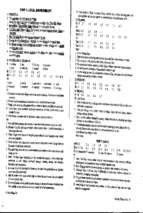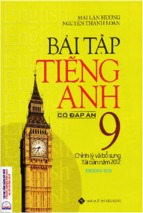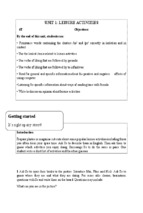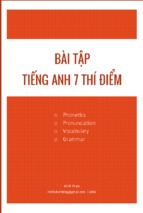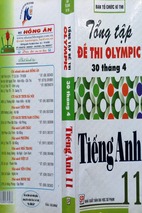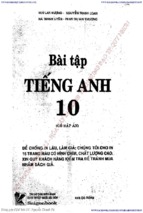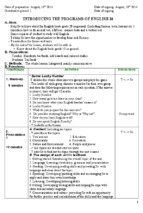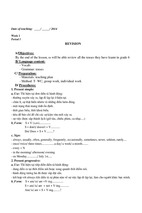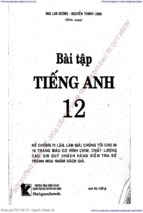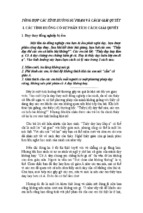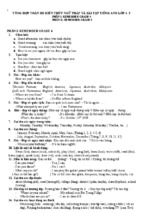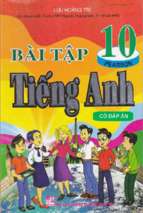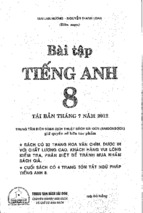Së GI¸O DôC & §µO T¹O H¦NG Y£N
TR¦êNG Thpt CHUYÊN
----------
Sáng kiến kinh nghiệm
“Phát huy tính hiệu quả của việc
chữa bài trong khi dạy viết luận cho
đội tuyển HSG
trường THPT Chuyên”
Họ và tên giáo viên: Nguyễn Thị Hường
Bé m«n :
Tiếng Anh
Năm học : 2013-2014
TABLE OF CONTENTS
PAGE
CHAPTER I: REASON FOR CHOOSING THE TOPIC…………………… 2
1. Reasons for choosing the topic.
2. Aims of the study
3. Significance and scope of the study
CHAPTER II: LITERATURE REVIEW…………………………………… 5
1. Definition of feedback and correctives
2. Corrective feedback in writing
2.1.
Corrective feedback in writing: varied feedback modes
2.2.
Corrective feedback in writing: some related issues
2.3. Corrective feedback in writing: teachers’ beliefs and practices
CHAPTER III: APPLICATIONS & RESULTS ………………………………23
1. Applications
2. Results
CHAPTER IV: CONCLUSION ………………………………………......... 38
1. Limitations of the study Results
2. Recommendations
3. Conclusion
REFERENCES ……………………………………………………………
40
CHAPTER ONE: INTRODUCTION
1. Reasons for choosing the topic.
Nowadays, English is considered to be one of the key factors that help our
country make faster progress on the way of industrialization and modernization.
Therefore, the demand to use English fluently as well as to master the four basic
skills is becoming essential among all students. Of the four skills, writing seems to
be the most difficult but really important. Therefore, helping students enhance their
writing skills is one of the teachers’ responsibilities. This can be done in a number
of ways. Second language writers often benefit most and make most progress, when
teachers contribute to this goal through a variety of intervention strategies available
in classroom settings.
Feedback is universally viewed as crucial for stimulating and consolidating
learning and its significance has been recognized by those working in the field of
second language learning in general and second language writing in particular. Its
importance is acknowledged in process-based classrooms where it forms the key
element of the students’ growing control of their composition skills and also by
genre-based teachers who exploit scaffold techniques as their teaching method to
build learners’ confidence. From an interactionist’s perspective, feedback is
considered to be the mean of establishing the significance of reader responses in
shaping meanings.
However, while feedback plays a central aspect of writing programs, the
research literature has not been raised positive about its importance in writing
development and it appears that teachers often adopt the sense that they do not bring
feedback to its fullest potential. Many questions involving feedback remain
unanswered or partially addressed: Does it make difference to students’ writing? If
so, in what areas? What is the best way of delivering feedback? Can error correction
and form-focused feedback have long-term benefits on students’ writing? Can
technology play a greater part in giving feedback? What role can peers’ feedback
2
play in writing development? How far does culture play a part in students’ response
to feedback? How can teacher feedback enhance students’ ability to independently
reflect on their writing? What are the implications of feedback for teacher control
and text appropriation? And just as importantly, what are students’ preferences for
feedback and error correction? It is assumed that students’ beliefs about what
constitutes effective feedback and their expectations regarding teachers’ papermarking techniques may influence effectiveness of such feedback (Schulz, 1996).
In reality, when I teach writing skills for my gifted students in Hung Yen
Specialised High School , I have found that corrective feedback is of great
importance for students to make progress in writing essays. That’s the reasons why I
choose the topic as my study with the hope that the results will raise teachers’
awareness regarding the way they provide feedback to their students. The
importance of writing skill to students call for adjustments to be made to the
methodology of teaching writing and the use of written feedback and oral feedback
are of significant value in this research.
2 . Aims of the study
The purpose of this study is to investigate the practices related to corrective
feedback on student writing with respect to the correction focus and correctiondelivering strategies to improve writing skill especially writing an essay for gifted
students in Hung Yen Specialised school. Within this context, the thesis is expected
to generate some recommendations and suggestions for the teachers to deliver more
effective feedback.
3. Scope and Significance of the Study
The study was conducted at Hung Yen Specialised High School, Hung Yen
province aiming at gifted students in English National Team.
In order for the mentioned-above aims to be achieved, the research attempts to
3
answer the following questions: What are teachers’ practices of giving corrective
feedback?
The scope is narrowed down to those following aspects:
-
What corrective feedback strategies the teachers are applying in their
writing class.
-
How much the amount of the teachers’ attention is being given on different
aspects of students’ writing.
-
Who is taking the main role in providing corrective feedback on different
aspects of writing?
-
When the teachers are providing corrective feedback towards students’
writing errors.
4
CHAPTER TWO: LITERATURE REVIEW
The literature review of the thesis is the compilation of written and published
knowledge on the topic of corrective feedback in writing regarding various issues
and insights. The review is drawn from previous studies done by famous applied
linguists.
1. Definition of feedback and correctives
Feedback is information given back to individuals about the adequacy of their
actions. Feedback is a reaction to a stimulus offered by the others. Feedback also
serves a regulatory function in that it prompts individuals to keep on tracks towards
a specified goal. However, feedback is not given just to keep individuals informed
about their behavior. The aim of feedback should be to make individuals think about
giving better responses (Cole & Chan, 1994).
Teachers give feedback to students in order to assist their learning. Lightbown
and Spada (1999) define that “many actions of teachers are properly classified as
feedback to students: grades given on exam papers, comments on assignments,
answers to questions asked by students, and remarks about students’ class work all
fall into this category” (p.234).
Correctives are extended form of feedback. They include augmented feedback
given to students as well as instructional procedures intended to rectify errors and
inadequacies in learning (Cole & Chan, 1994). Corrective procedures concentrate on
what has to be done to get students back on track to state of proper understanding of
subject content. Correctives include a variety of instructional procedures, ranging
from providing alternative cues or additional practice, to re-teaching aspects of
subject matter using different materials and strategies. They include prompts, hints,
suggestion regarding strategy use, reminders about methods, further demonstrations
and explanations, even suggestions to abandon inefficient strategies. In all such
cases these are supplied after the students have tried to learn on their own.
Correctives are often necessary in classes where there are a good number of students
5
with learning problems. Some students benefit from corrective instruction based on
traditional teaching strategies, while others require more innovative approaches. In
most whole- class teaching situations, it is inevitable that some students will exhibit
inadequacies in performance or errors in learning that need the use of correctives.
2. Corrective feedback in writing
2.1. Corrective feedback in writing: varied feedback modes
Since the late 1980’s, there has been a switch in the teaching of writing from a
focus on product to a focus on process. The process-oriented writing approach,
therefore, shifts the core of writing instruction away from students’ final products
towards their writing processes, which include pre-writing, drafting, revising and
editing stages. Feedback, as a factor of great significance in the writing process,
calls for wide concerns from EFL/ESL teachers. For a long time, product-oriented
approach dominates the writing pedagogy and teacher feedback is used as the only
way to respond to student writing. New feedback modes are burgeoning and varied
feedback techniques are explored along with this new development in writing
pedagogy.
2.1.1 .Peer feedback
Peer feedback, also referred to as peer response, peer editing or peer review, is
one type of feedback frequently recommended by process advocates. It continues to
be a popular source of in EFL/ESL classroom. It is defined as working with
someone of relatively equal language proficiency and of one’s own age- usually
someone in the same class- to help improve, revise and edit his or her writing. The
beneficial effects of peer review have been outlined in substantial amount of
research.
Peer readers can provide useful feedback. For example, Rollinson (2005) found
high levels of valid feedback among college level students. 80% of comments were
considered valid and only 7% were potentially damaging.
It has also been shown that peer writers can and do revise effectively on the basis
6
of comments from peer readers. Mendonca and Johnson’s (1994) study showed that
53% of revisions made were incorporations of peer comments. Rollinson (2005)
found even higher levels of uptake of reader feedback, and 65% of comments were
accepter either completely or partially by readers.
According to Li (2009), peer feedback, cognitively, force students to exercise
their thinking and help them enhance audience awareness. Linguistically, students
experience through peer review valuable opportunities to enhance their reading and
writing ability as they discuss such issues as writing contents, organizational
patterns, grammatical structures and appropriate word choices. Affectively, through
peer feedback, students can gain confidence and reduce apprehension by seeing
peers’ strengths and weaknesses in writing and therefore generate more positive
attitudes towards writing. However, some literature reports that peer response
cannot achiever fruitful results because students are not knowledgeable enough for
error detection and corrections or they tend to withhold critical comments in order to
maintain group harmony.
2.1.2. Self-monitoring
Self-monitoring technique is also a potentially rewarding option in the ESL/EFL
writing class. Based on the literature developed by Cresswell (2000), selfmonitoring students write marginal annotations about problems in their evolving
compositions, to which the teacher responds. Students are asked to annotate their
text with any doubts they have during the writing process. Research on this
technique provides an increasing number of advantages for students of writing.
Firstly, the passive position of the writer has been totally changed into an active
audience in the writing process (Charles, 1990, cited in Chen, 2009). Clear evidence
indicates that lack of critical thinking and active attitudes is the most common
problem during ESL students’ learning process (Matalene, 1985). According to the
study presented by Matalene through examining and analyzing ESL writing, ESL
writers show their perspectives that comprehending their writing is only the
7
audience’s responsibility and few of them judge their own writing from a reader’s
objective view. This characteristic originates from the traditional thought that
writing is only the matter of the writer and writing is not for showing off but selflearning. Another reason that explains why ESL writing learners tend to take a
negative attitude on their production is the traditional teacher-centered educational
model (Huang & Leung, 2005, cited in Chen, 2009). That is, getting used to this
teaching model, students prefer reception rather than production, being a good
listener and reader but an inexperienced thinker and writer. However, making
annotations reflecting the writer’s concern, student writers have to force themselves
to form an awareness of the audience for their writing. And this technique pushes
them to evaluate their work more objectively and to express motivation instead of
only writing without thinking. Besides, it encourages writing learners to develop the
responsibilities for what they write and drives them to participate in the whole
writing process.
Secondly, self-monitoring encourages students to look critically and analytically
at their writings and helps enhance their learning autonomy. It meanwhile enables
the teacher to give tailor-made feedback to individual students and offers a match
between the feedback that students want or expect and the feedback that is actually
given.
What remains a problem, nevertheless, is that this feedback seems inapplicable
to all students. Some self-monitoring learners cannot adequately describe their
concerns or cannot locate the problems in their writing. The questions they are too
general or some are written down too casually or many students still prefer to rely
on their teacher for comment rather than exercise their individual judgments. In
addition, the effectiveness of self-monitoring technique partly depends on the
feedback that the teacher provides. Hence, teacher-student conference is encouraged
after the teacher looks over students’ annotations, which means teachers and
students schedule a meeting time when the teacher explains the solutions to
8
students’ problems and points out the other important issues ignored. During the
conference, teachers should create harmonious atmosphere for substantial
negotiation and deep communication. They take an easy-of-approach attitude to
discuss students’ problems as well as offering sincere encouragements and
constructive suggestions.
2.1.3. Teachers’ written corrective feedback
Despite growing attention to oral response and the exploitation of peers,
computers and self-monitoring model as sources of feedback, written comments
from instructors remain central in most L2 and foreign language writing classes.
Many teachers have the notion that it is necessary for them to write substantial
comments on writing papers to provide reader reaction to students’ effort, to help
them improve as writers and to justify the grade given ( Li, 2009).
As a traditional feedback mode, it bears many advantages that cannot by
surpassed by other feedback techniques. It provides a critical instructional
opportunity for students and offers a convenient avenue to achieve one-to-one
communication that is rarely possible in the day-to-day operations of a class.
One of the important points of using written feedback is that it serves as the
motivation factor in the ESL writing process. Ellis (1994, cited in Naidu, 2007)
reminds us that students' motivation is closely linked to language acquisition. To
motivate students, the writing teachers can include comments of praise and
encouragement in their written feedback. These written comments are to help
students to clarify meaning in their rewrites. Further, Ellis (1994, cited in Naidu,
2007) notes that the teachers' use of referential or open (information seeking)
questions may result in more meaning negotiation and more complex learner output.
Hyland and Hyland in their 2006 review looked at research carried out in the
1980s and the early 1990s and concluded that studies in this period began to
challenge the effectiveness of teacher feedback as a way of improving students’
writing. Early research on native English speakers (LI) suggested that much written
9
feedback was of poor quality and was frequently misunderstood by students.
Written response was blamed as being vague, inconsistent and authoritarian, overly
concerned with error and often functioning to appropriate, or take over, students’
texts by being too directive.
According to Li (2009), in Chinese EFL writing context, there is usually no
variation in teacher feedback technique. Teachers more often than not review
students’ writings word by word and correct every single problem they find in their
writings which is really time-consuming and labor-intensive. Unluckily, however,
their great efforts are not fully valued, for students seldom reflect on the mistakes
they have made or trouble how to avoid repeating them. Even worse, teachers’
drowning on students’ writings with red pens may harm students’ interests and
motivation in writing. Literature on how to make this conventional feedback mode
benefit students better will be discussed further in subsequent parts of this thesis.
2.1.4. Teacher-student conferencing
As written comments may prove very difficult for ESL/ESL students to
comprehend and to act upon, Zamel (1985) recommends that teachers and students
carry out a face-to-face dialogue that is known as the conferencing session so that
"dynamic interchange and negotiation" as stated by Zamel (1985) can take place in
addition to written feedback. Xu (1989) contends that in one-to-one conferences,
perceptive teachers can reduce students' anxiety, trace the cause of the problems,
and apply strategies for enhancing language acquisition.
In many ways, one-to-one conferencing, whether it is student teacher or thirdparty conferencing, is the most advantageous method for ESL students. Students
who have three or more conferences in a term not only improve their writing ability,
but also significantly improve their listening and speaking skills (Brender, 1995).
The teacher or tutor should, however, be aware of the special needs of these
students. Also, according to Brender (1995), one serious problem that often occurs
in conferencing is that teachers and tutors talk down to their students. Other areas in
10
which students are at a disadvantage in one-to-one discussions which include types
of questions asked, the length of pauses after questions, turn taking, and the
proportion of time each participant speaks per turn, methods of negotiating meaning,
and methods of wielding power. Harris (1986) contends that teachers and tutors
need to listen to students more attentively and become more adept at a certain kind
of listening in order to establish a non-judgmental setting where there is no penalty
for trying out new ideas.
2. 2. Corrective feedback in writing: some related issues
2.2.1 Corrective feedback in process-oriented writing classroom
The process movement is originally a reform effort in improving teaching
composition to native English speaking students. It advocates an approach to
composition teaching that emphasizes student writing process rather than the
product.
Most TESOL writing classes in the 1960s tend to focus on producing wellpolished compositions. Typically, students analyzed ‘correct’ model compositions
and then attempted to produce something akin to them. This traditional approach to
the teaching of writing, the product-oriented approach, has been concerned with
usage, structure or accurate form of written works. But this began to be criticized by
some early reformers since 1970s. They pointed out that teachers designed, assigned
writing topics and evaluated students’ work without giving any thoughts to what
happened during the course of writing, nor did they assist students in their writing
actions. They claimed that the emphasis in the correct usage of grammar and style in
traditional writing classes did not help students developed their writing skill because
writing was not a simple act of recording thoughts in a correct linguistic form as it
was conventionally believed, but a very laborious process of discovering thoughts
that involved various complicated competences and skills (Raimes, 1983, cited in
Zeng, 2005).
The introduction of the process approach exerted a major impact on ESL writing
11
instruction, though the changes came gradually. ESL teachers in the early 1980s
began to borrow techniques from English composition class and textbooks in the
process approach began to appear, providing ESL learners with real writing
experience. For instance, ‘Exploring through writing: a process approach to ESL
writing’ by Raimes (1989) was a popular textbook for ESL learners for years.
Process-oriented ESL teachers provided students with ample time to write on topics
of their choice and ESL learners were encouraged to use language to explore, to
voice and share their beliefs, values and experiences. Teaching effective strategies at
each stage of the writing process became an important component of a writing class.
As Reid (1983, cited in Zeng, 2005) observed, "since the middle of the 1980s, many
ESL writing teachers had discovered, accepted and implemented the approaches and
philosophy associated with the writing process.” (p.64)
With respect to error correction, Zamel states that it is important to find out why
students are making certain errors before prescribing corrective measures.
Instructors can then determine which errors are the result of carelessness and can be
dealt with by closer proofreading and editing and which are the result of incorrectly
formed rules about the target language. In any case, issues of content and meaning
must be addressed first ... language is of concern only when the ideas to be
communicated have been delineated (Zamel, 1985).
On the other hand, students, before they are initiated into process-oriented
writing, are very much concerned with the correctness of their writing and perceive
good writing as correct writing, whether or not they actually edit for errors. In a
survey of attitude towards writing, the researcher reported that 84% of ESL students
consider getting the grammar correct to be the most important part of their writing
in English, 52% getting the punctuation correct and a meager 20% communicating
ideas (Bosher, 1990).
Because the paradigm shift in ESL writing instruction form the product to the
process of writing is still very recent and incomplete, it is especially essential that
12
editing skills be understood within the overall context of writing, as the final, cleanup stage in the process. We must be careful that students not become overconcerned with correctness. Samuels’ 1985 survey also found that 85% of ESL
writers in the first year of college thought about grammar, spelling and punctuation
as they were writing the words of their paper and 15% after they had finished
writing the whole paper: This strengthens Raimes’s finding that inexperienced ESL
writers edit as they are working an idea, not afterwards as a clean-up operation.
Such a preoccupation with errors can interfere with, if not prevent, the writer’s
ability to discover and make meaning.
2.2.2. Accuracy versus fluency in a writing class
2.2.2.1.
Accuracy/Fluency dichotomy
The accuracy/fluency dichotomy has provided ESL/EFL teaching field with a
wide arena for both research and dispute. As the trend towards communicative
competence continues, with its concomitant concentration on meaning as opposed to
on form, fluency becomes more of target for curriculum development and the
previous stricter views towards learners’ errors have been supplanted by
methodologies with more relaxed outlooks (Humphries, 1996).
With regard to writing skills, Rivers (1968) recognized that sheer accuracy was
unreasonable, but countered that without some insistence on accuracy, particularly
academic writing, would suffer markedly.
On the other hand, a variety of other researchers, such as Zamel (1982), have
stressed the need to emphasize writing in second and foreign language classrooms
as a process of discovery, and that over emphasis on errors and rhetorical forms can
inhibit this process.
For the teacher in an academic ESL/EFL situation, there is something of dilemma.
It is desirable that learners develop effective and creative writing strategies to
enable them to use writing as a communicative tool. It is also expected that they
acquire the grammatical and rhetorical forms which they may have to demonstrate
13
competence in, in future academic or work-related settings. The idea that difficulty
with form will correct itself over time is unconvincing to many teachers who do not
wish to neglect accuracy completely. It is suggested to adopt a balanced approach,
allowing students to produce their own ideas in written form with guidance from the
teacher in order to produce a correct form (Brumfit, 1984, cited in Humphries,
1996). He also notes that it is possible to create the conditions for group revision
and improvement of written work, so that the accuracy activity is turned into
something of a conscious but relatively spontaneous exercise, for talking about
accuracy may be fluency talk.
2.2.2.2. Teacher response to student writing: focus on form versus focus on content
While reading on student writing, teachers often ask themselves, ‘how can I give
the best feedback to help my students improve their compositions?’ The answer is
hard to be found because there is little agreement among teachers and researchers
about how teachers should respond to students’ writing (Fathman & Whalley,
1990). Much of the conflict over teacher response to written work has been whether
teacher feedback should focus on form (e.g. grammar, mechanics) or on content
(e.g., organization, amount of details).
The second language research on composition has focused both on how teachers
correct form and how teachers respond to content. Authors of research studies in
this study draw different conclusions. Focus on form in some cases appears to be
effective in helping students write better, in others it is not. Hendrickson (1978)
found that providing the correct form, in addition to noting the errors, has no
statistically impact on students’ writing proficiency. Lalande (1982), on the other
hand, found that his experimental group, which was given on the kind of errors
made, showed significant improvement over the control group, whose errors was
simply corrected.
In the area of teacher feedback on content, there are fewer studies. In one, Zamel
(1985) examined the way teachers give feedback on content. She reached the
14
conclusion that ESL teachers are very much like LI teachers. Their comments on
content are vague and contradictory. In addition, students tended to respond to
comments on form and ignored those on content.
In an experimental research study, Fathman and Whalley (1990), students in
various classes were randomly assigned to one of the four groups. The students on
each group received a different kind of teacher feedback on their compositions:
Group 1 received no feedback, Group 2 received grammar feedback only, Group 3
received content feedback only, Group 4 received both grammar and content
feedback. The results from this study suggest that grammar and content feedback,
whether given alone or simultaneously, positively affect rewriting. The
identification of the location of errors by the teachers appears to be an effective
means of helping students correct their grammar errors. Further, grammar feedback
by the teachers in this study had more effect on correction of grammatical errors
than content feedback did on the improvement of the content of students’ rewriting.
This might well be due to the fact that the content feedback was not text specific
and was more general than the grammar feedback that clearly showed specific
grammar errors.
Students made more improvement when feedback was given than when it was
not. However, a majority of students did receive higher scores on grammar and
content of their rewrites than on their original composition without any intervention
from teachers. Students significantly improved the content and wrote longer
compositions when they did not receive feedback, which implies that rewriting is
worthwhile and teacher intervention is not always necessary.
The results from this study also suggest that when grammar and content feedback
are presented at the same time, the content of rewrites improves approximately as
much as when content feedback only is given. Focus on grammar does not
negatively affect the content of writing. This would further affirm that students can
improve their writing in situations where content and form feedback is provided
15
simultaneously.
2.2.3. Comprehensive feedback versus selective feedback
How should writing teachers mark errors? Excessive attention to errors may
prove frustrating for students and exhausting for teachers. When teachers treat errors
comprehensively, the onus of correction is inevitably on themselves, which makes
students reliant on teachers. Also, when teachers do nothing with students’ error,
there is less time for feedback on other perhaps more important aspects of writing
such as content and coherence (Lee, 2005). Research in L2 has found that L2
writing teachers to pay more of their attention to formal correctness than to the
discourse level of writing, which may lead students to believe that formal accuracy
is more important than the transmission of meaning, overall organization and
content development.
In recent years, selective error correction has become a very popular and
widespread practice. Its popularity is based on a number of well-known problems
with the more traditional practice of comprehensive correction. For the teachers, the
latter can be extremely unpleasant and time-consuming, problems which are almost
certain to result in a lower quality of correction. For students, the sea of red ink on
their assignments is likely to prove quite discouraging, and even the most highlymotivated students cannot be expected to adequately deal with every error on their
work (Truscott, 2001). Partly for these reasons, standard thinking is now that
correction must be used selectively.
2.2.3.1 .Developmental sequences
Good evidence shows that much of grammar is acquired in more or less
predictable sequences, and that efforts to teach things and correct things out of
sequences are misguided. The existence of sequences thus imposes important
constraints on the prospects for correction - aspects of grammar for which learners
are not yet ready are not good candidates for correction. Identifying and respecting
the current stage for individual learners is impractical, therefore, teachers cannot be
16
expected to base their correction on students’ readiness for specific construction.
For this reason, errors that are related to developmental sequences are not good
targets for correction and errors that are related to any known order of acquisition
are more promising (Bardovi-Harlig, 1995)
2.2.3.2. Which errors are most correctable?
Truscott in his 2001 article ‘Selective errors for selective error correction’
classifies errors in terms of their level of correctability as follows:
Low-correctability errors
Syntactic errors in general make poor targets for correction. As they are
typically not simple or discrete, often involved in developmental sequences and
tend to be intimately associated with universal grammar.
Moderately correctable errors
All these form of grammar correction are most promising with the type of errors
that result from misapplication of known principles to an identifiable of an
individual case, usually a word. Such errors include misclassification of words
(e.g., treatment of a mass noun as a count noun); attachment of an inappropriate
derivational affix to a word and use of given construction such as dative with
inappropriate words.
In comparison with those considered above, these errors are simpler and more
discrete as they are tied to individual words and appear to have less involvement in
developmental sequences.
Relatively high-correctability errors
Higher on the correctability scale are lexical errors less tied to general
principles. These include misspelling of isolated words, simple errors in a word’s
meaning, the forms of idioms and other very restricted collocations, mistaken of
association of a particular preposition with a particular word or failure to make such
association when necessary, etc.
Each of these error types fares well on all criteria considered here, as each
17
involves problems in relatively simple, readily indentifiable items. These are errors
that teachers and students can most easily recognize, understand and apply to new
contexts. In general they do not seem to be involved in developmental sequences
and are the less tied to Universal Grammar.
Based mainly on practical and empirical considerations, Truscott suggested that
certain types of errors are more correctable than others and are therefore more
appropriate targets for selective correction.
2.2.4. Direct vs indirect coded feedback
BirecTerror feedback, i.e., overt correction, is provided when the correct form is
written on students’ papers whereas indirect error feedback is provided if the
teacher indicates the location of the error indirectly by underlining, highlighting or
circling, or indirectly by indicating in the margins that there is an error on that line
but without providing the correct form (Lee, 2005). Indirect feedback is regarded as
coded error feedback if the indication of the error is done by a symbol representing
a specific kind of error (such as T for verb tense or Sp for Spelling). If the
indication of the errors is done by the kind of error (spelling, verb tense), it is called
uncoded error feedback. For editing a paper with indirect feedback on, the student
is required both to indentify the type of errors and to self correct the error whereas
in direct feedback, what students do is only to transcribe the teacher’s corrections
into the paper (Ferris, 2003).
There is research evidence proving that indirect error feedback is more helpful
on long-term writing development than direct error feedback. Chandler (2003)
examined two ESL undergraduate groups receiving either direct or indirect error
feedback for a 14-week semester. The result showed that indirect error feedback
with student selfediting contributes to accuracy more than direct error feedback. In a
similar study, Lalande (1982) compared two groups: one with direct feedback and
the other with indirect feedback using correction codes over a semester. All students
were required to second draft by using this feedback. It was found that the group
18
with indirect coded feedback had more accuracy in writing by the end of the
semester.
However, in another longitudinal study by Robb, Ross and Shortreed (1986), no
significant difference was found among for groups of students who received four
different types of error correction feedback. These were (a) direct correction; (b)
indirect code feedback; (c) indirect highlighted feedback (no codes); and (d) indirect
marginal feedback. The result is that all four groups improved in accuracy over time
but the differences among the groups are not statistically significant.
2.2.5. Timing of feedback and correctives
Cole and Chan (1994) suggest that teachers should give feedback and correctives
after students have made genuine attempts to complete assigned tasks. Students
learn best from situations in which they have been acquired to respond to questions
before a teacher give feedback. Little learning is achieved when students are
consistently told the answers before they have had the chance to attempt the task. It
is well documented that students learn little from a set of problems when they
simply copy or imitate correct answers. Further, when the answers are provided in
advance, students will not perceive the need to try to find their own solutions.
Another principle regarding the timing of feedback is that it is vital for teachers
to give frequent feedback and corrective during the early stages of learning a new
subject matter. Students will learn more quickly if regular feedback is available
during the initial stages of learning. If early errors in the process of acquiring new
knowledge are uncorrected, they may interfere with subsequent learning.
Furthermore, when students are allowed to practice errors, inappropriate ways of
writing gradually consolidated and such persistent errors can be difficult to eradicate
(Cole & Chan, 1994)
There are also disagreements regarding immediate feedback and delayed
feedback. While immediate correction interrupts learners’ writing flow and may
have negative effects, delayed correction in successive sessions may also be
19
- Xem thêm -

